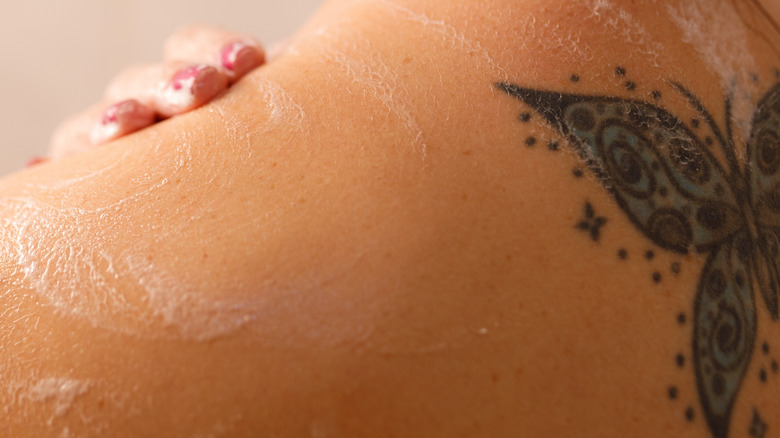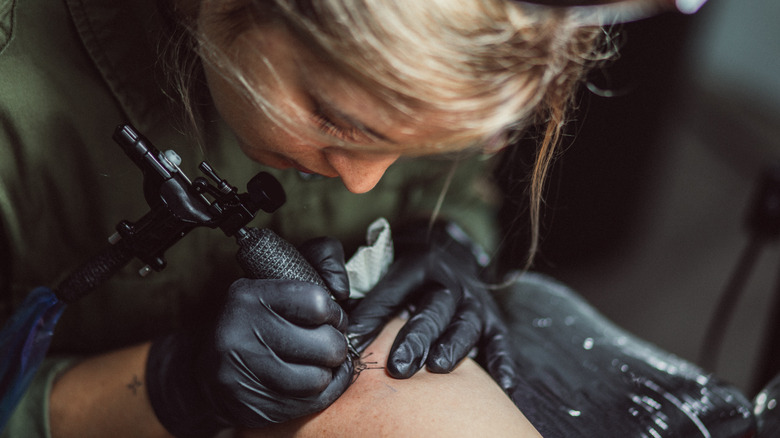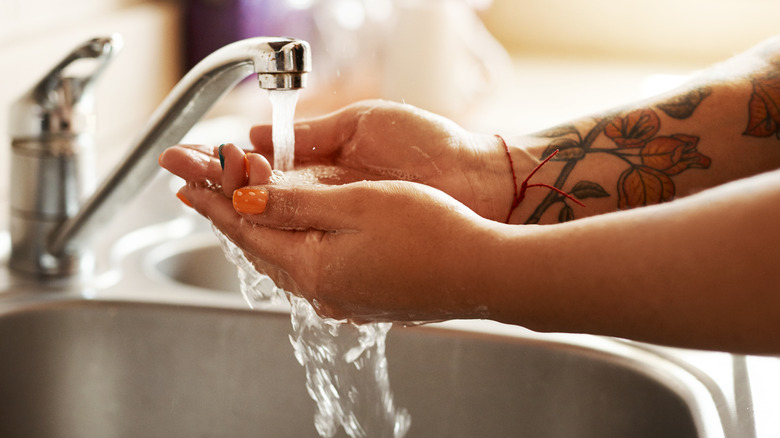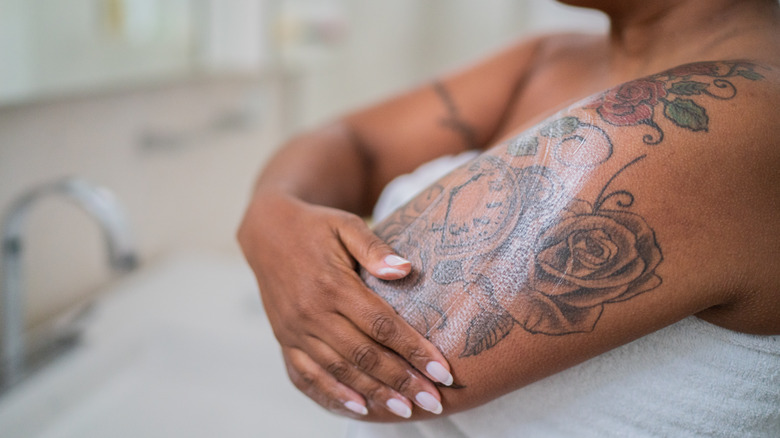When & How To Wash Your Body After Getting A New Tattoo
Tattoos are a billion-dollar business. In the U.S., 27% of people pay up to $100 for tattoos and 6% have dropped $2500 or more on their tattoos. In other words, tattoos aren't cheap and if you're willing to invest even $100, you want to make sure it looks great, well, forever.
One of the major factors in having a tattoo that stands the test of time is how you take care of it in the first couple weeks after getting it. Especially because, although we don't tend to think of tattoos as abrasions, that's essentially what they are. "As the tattoo is being administered, it's intentionally damaging the skin, creating thousands of tiny wounds," board-certified dermatologist Geeta Yadav, MD told Self. "After you get a tattoo, you'll essentially be walking around with an open wound." And like any wound, it needs to be coddled and protected so it can heal quickly and not leave behind any scars.
Although where your tattoo is and the size of it plays a big role in the immediate aftercare, some general rules of thumb should be followed when it comes to washing it the first few times. These initial cleanings are crucial to the life and look of your tattoo.
Wait about 24 hours
After your tattoo is done, the artist is going to wrap it up before you leave the studio. Some artists use special adhesives that almost look like clear packing tape, while others just use regular ol' cling wrap with body-friendly tape. The covering is there to not just protect your fresh wound, but maintain the integrity of the ink. "Depending on the size and advice of the artist, you'll need to keep your tattoo wrapped in cling film from one to three days," tattoo artist Ghinko told Good Housekeeping.
As much as you may want to pull back or entirely remove this protection, don't do it. The tattoo must have time to heal in that block of 24 to 72 hours. Besides, what you'll see in those first couple of days isn't going to be the result. New tattoos tend to be swollen and red, and some even bleed both ink and blood — which is normal — so you won't get a very good idea of what it's going to look like until after about six months of healing.
Keep things gentle
When you do finally wash it, you want to keep things as gentle as possible. That means no hot or cold water, or cleansers that are too strong. "Use lukewarm water and do not directly soak the tattoo for too long," micro and fine-line tattoo artist Syd Smith told Byrdie. "You should also avoid scrubbing your tattoo or using harsh soaps as that can irritate healing skin." A basic antibacterial soap is all you need.
Wash it with your hand in a circular motion. Your fingers are more sensitive to the touch than a cloth would be, so you're less likely to be aggressive if you use your hand. When tattoos are healing, they can be incredibly itchy, but you want to resist the urge to scratch. Not only can scratching or picking at the tattoo possibly cause infection, but you could do some serious harm to the tattoo itself by shifting the ink about in ways that can ruin it and cause problems in the healing process.
Stick to showers
As any tattooist will tell you, you want to avoid bodies of water like the plague. Whether it be a bathtub, pool, or a romp in the ocean, submerging your tattoo can be problematic. Not only does the water prevent it from healing properly which can mess up the colors, but these places are rife with bacteria. You simply don't put an open wound where bacteria can have its way and cause an infection. "During the next several weeks, the tattoo itself may appear healed on the outside, but the deeper skin layers are continuing to repair themselves," board-certified dermatologist Joshua Zeichner, MD told Business Insider. Because of this, you want to stick to showers for those first few weeks. When you get out of the shower, make sure you pat your tattoo dry, as opposed to rubbing it. Again, you want to limit any additional trauma to the area.
Tattoos are fantastic and a creative way to decorate our bodies, but they do require some upkeep. Even after those first few weeks, you want to make sure you take steps to maintain the colors and shape by applying sunscreen daily. Both lifelong sun screening and initial care are paramount to the health and longevity of your tattoo.



